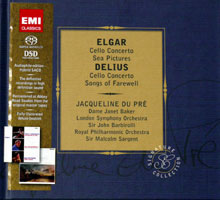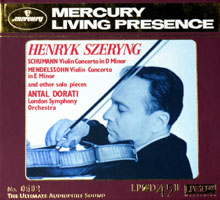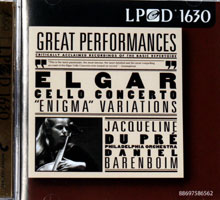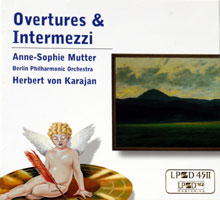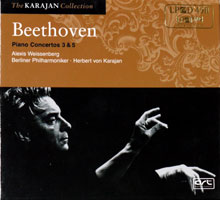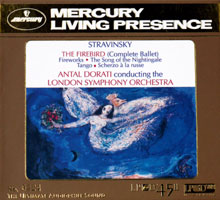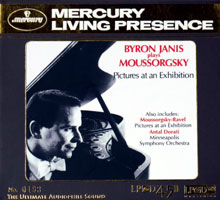Tempting
Titles From Somewhere Else
Of course, the Internet makes it considerably easier to stay abreast of favored sources, and somewhat easier to actually lay hands on objects of desire. But where it is no help at all is when it comes to discs you don’t even know exist. My trips to Hong Kong turned up two examples of highly desirable material appearing in formats in which I had no idea they were available, and two formats that I didn't even know existed. I’ve already written about my experience with Glass CD, thanks to the generosity of Lincoln Cheng at Audio Technique magazine. But that still leaves one entirely new mastering format and a whole host of material in potentially superior pressings to consider.
It’s my wallet footing the bills, so I’m afraid that you get stuck with my taste in material, tempered by a choice of titles destined to deliver a good story. That means mainly classical and mainly what might be referred to as Golden Age recordings. However, if you want jazz, the titles are out there too, and when it comes to identikit Chinese female pop vocals, the world is pretty much your oyster. Throw in a few traditional Japanese compositions and instruments and there’s no shortage of choice. Regular readers will be well aware of my affection for Jacqueline du Pré and her readings of the cello repertoire, particularly the Elgar Concerto, where my preference tends to her live recording with Barbirolli and the BBC Symphony, captured in Praque for radio broadcast and belatedly available on Testament [SBT 1388]. Well, that could be about to change. How about a double SACD reissue from EMI, including the famous du Pré/Barbirolli/LSO studio recording, paired with the fabulous Janet Baker Sea Pictures (previously [ASD 655]), along with the du Pré/Sargent/LPO reading of the Delius Cello Concerto and Six Songs (previously [ASD 644])? I never even knew this stuff was available on SACD. Another find -- indicating the nature of different markets more than anything else -- was an Orfeo SACD release of a live Kleiber/Bayerische Staatsoper performance of the Beethoven 7th Symphony. I’d have been pretty happy with just those two, but they don’t even scratch the surface. Next up, how about 24-bit digital transfers to gold CD of two Decca classics? First, the legendary Argenta/LSO Espana [SXL 2020] is too good to miss, especially given the ready comparison it offers to original and reissued vinyl versions, as well as the various CD issues. More of a sleeper but musically even more impressive are the David Oistrakh performances of the Bruch Scottish Fantasia and Mozart Sinfonia Concertante (the latter with Oistrakh's son Igor on viola). Drawn from two Decca LPs [SXL 6088 and SXL 6035], both of which are available from Speakers Corner and also on LIM XRCDs, these are fantastic performances that hit that all-too-rare jackpot of great music and great sound. Finally, a new mastering format -- or new to me, at least: LPCD makes its intentions pretty clear just from the nomenclature. Again, these are Red Book discs, the difference being in the mastering technique and hardware -- similar in that respect to XRCD, the discs they most resemble in terms of presentation too. I actually first came across this format in the shape of an EMI Hong Kong reissue of Karajan and the BPO performing Beethoven’s 3rd and 5th Piano Concertos, with Alexis Weissenberg as soloist. Opinions on these performances vary, but there’s no doubting who holds the whip hand, the piano, for all the contained poise of Weissenberg’s playing, occupying a strictly subordinate role, with no conversation of equals here. I can’t say that these performances are to my taste (if only they’d reissued the Triple Concerto from the same period), but the sound definitely is. In fact, the sonic merits of the disc made me determined to seek out more attractive material and the choice proved to be wide. I picked up the following: Mutter, Karajan and the BPO – Overtures and Intermezzi. A far more successful collaboration than the Beethoven readings. du Pré – Elgar Cello Concerto. Another EMI du Pré/Elgar, but this time the later recording with husband Daniel Barenboim conducting the Philadelphia Orchestra. I just couldn’t resist. Four Mercury Living Presence titles, all with Dorati, three with the LSO. These consist of Szeryng performing the Schumann and Mendelssohn Violin Concertos, the famous Janis performance of the piano transcription of Pictures, paired with the standard Ravel orchestration, both featuring the Minneapolis SO, and then two legendary titles, the Stravinsky Firebird and Starker’s performance of the Dvorak Cello Concerto. Plenty of room for comparisons there, as virtually all of these Mercury titles have been reissued at one time or another, either by Speakers Corner on vinyl or on various digital formats. But perhaps the most interesting thing about my musical haul is not the quality or quantity, but the source of all these discs. Far from trawling the many, many software stalls at the Hong Kong Show, I bought all of these titles at the excellent HMV store, tucked away on the third and fourth floors of an office complex in Central. Prices varied, from around $13.50 (for the EMI titles) up to nearly $30 for the Mercurys, but both the range of titles on offer and space/signage given over to them suggests that they sell in volume -- at least in Classical terms. Time, then, to look at a couple of these discs in detail. Going straight for the most popular titles, let’s look at the Decca gold disc of Espana [Universal 4806154] and the Starker Dvorak Cello Concerto on LPCD [Hugo 4806139]. The first of these is easy; the 24K-gold disc and transfer certainly have their merits, with better tonality and instrumental identity and separation than any of the other digital discs I have. But the Classic Records reissue and the XRCD both exhibit greater depth and sense of overall acoustic space, while none comes close to the Speakers Corner reissue or a wideband original pressing. So, an interesting addition to the offerings out there, but in no way a compelling purchase -- especially if you already own one of the other audiophile digital discs or a decent LP pressing. The LPCD disc of the Starker is far more interesting. With original CD and SACD issues on hand, as well as a multitude of various original and reissued LPs to pick from, I’m pretty much spoiled for choice when it comes to my favorite Mercury recording. Even so, the LPCD has quickly carved a niche as my preferred digital rendition. It easily betters the original CD, with its flat, murky sound, as well as the CD layer of the later SACD issue. Where the comparison gets more interesting -- and the disc’s nomenclature starts to justify itself -- is once you start comparing it with the SACD and vinyl versions. The LPCD doesn’t have the stark transparency and crisp dynamic steps of the excellent SACD, but it is musically and spatially more coherent, with a warmer, weightier overall tonality and a definite analog quality to its sound. Back-to-back comparisons, especially with the Speakers Corner reissue (as opposed to the more immediate and explosive sound of the originals), show that it is certainly closer in overall presentation to the LP versions than either of the digital alternatives. Where the SACD plays to that format’s strengths, the LPCD genuinely echoes the sound and presentation of vinyl. And it is not just a tonal thing -- a little bit of roundness or added warmth in the bass. This is far more fundamental than that. What gives the LPCD its analog quality is its overall sense of spatial and temporal coherence. The soundstage presentation -- and the beautiful harmonic balance that goes with it -- was what I’d picked up on the Karajan disc [EMI Hong Kong 5099973004820]. What the Dvorak [Hugo 4806139] revealed, through the opportunity to make direct comparisons to vinyl pressings, was that the sense of continuity that characterized the acoustic space and harmonic development extended into the time domain. The LPCD displayed significantly better rhythmic placement and expression, a dramatically better range of tempo and phrasing than any of the other digital discs, and it was this that really moved it closer to the sense of performance and communicative virtues of the LPs. In fact, it gets very close indeed. The romantic sweep and structured phrasing of the Dvorak demands exactly this quality, especially when it is delivered under the baton of Dorati, with his strictly measured tempi and ability to accent with a meaningful pause. You’ll only need to listen to the opening of the first movement to appreciate that this LPCD is something special, but the whole performance enjoys exactly the same dramatic quality. It may not have quite the dimensional presence and solidity of the LPs, but it gets awfully close to their impressive vibrancy and the complex energy they capture from Starker’s cello. On this showing (and the evidence of the other discs
here), LPCD is certainly worth seeking out. As far as I’m aware, it is not currently
available through any of the existing audiophile or mainstream classical outlets, although
the Starker disc is available from Chia Chia Record if you can penetrate the page. In the meantime,
I’m going to see if I can find a more amenable mail-order source for English-speaking
customers, because these discs are well worth seeking out. |

